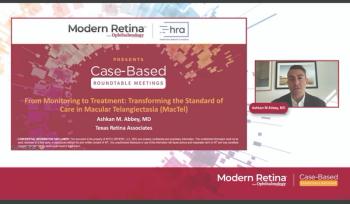
Long-term aflibercept effective for nAMD after other anti-VEGF therapies failed
Aflibercept (Eylea, Regeneron Pharmaceuticals) intravitreal injection, administered according to an as-needed regimen, improved the anatomic outcomes in many eyes refractory to monthly bevacizumab or ranibizumab injections that had persistent or recurrent fluid. However, half of the patients might require aflibercept injections every 4 weeks in order to achieve a completely dry retina.
San Diego––Aflibercept injections were beneficial for patients who were previously treated with other anti-vascular endothelial growth factor (VEGF) drugs and who showed persistent or recurrent fluid resulting from their neovascular age-related macular degeneration (nAMD).
Although the patients’ anatomic findings improved, the visual acuity (VA) remained the same during the 2-year, follow-up period in most patients, according to
Related:
In this retrospective, single-center, interventional, consecutive case series, all patients had been treated with intraretinal injections of bevacizumab (Avastin) or ranibizumab (Lucentis, both from Genentech) and were administered by the same retina specialist, reported Dr. Muftuoglu, the lead author of the study.
Patients had persistent intraretinal or subretinal fluid for 5 months or more–or had multiple recurrences of fluid–after being completely dry at multiple visits during follow-up. They then were treated every 8 weeks with an as-needed regimen of aflibercept (Eylea, Regeneron Pharmaceuticals) injections until the complete resolution of intraretinal and/or subretinal fluid.
Injections escalated
If the fluid persisted despite this treatment for 5 months, the regimen was escalated to every 4 weeks of as-needed aflibercept injections. No loading dose of the drug was administered due to the partial treatment with anti-VEGF agents other than aflibercept, Dr. Muftuoglu said.
All patients underwent spectral-domain optical coherence tomography (SD-OCT) imaging during the follow-up. At each visit, the investigators evaluated the anatomic outcomes that included the maximal retinal thickness, central macular thickness, maximal height of pigment epithelial detachments, maximal height of the retinal fluid, and visual acuity (VA).
Recent:
A total of 81 eyes of 78 patients were included in the study, and the numbers of patients with recurrent or persistent fluid were similar. The patients had received a mean of 14 injections of an anti-VEGF drug other than aflibercept. The patients were followed for 24 months and received a mean of 11 injections of the drug during the course of the study, Dr. Muftuoglu said.
“After 3 consecutive bimonthly injections, patients showed significant improvement in all anatomic outcomes and this improvement was maintained during the 2-year follow-up,” Dr. Muftuoglu added.
The investigators reported their findings in the American Journal of Ophthalmology (2016;167:1-9).
Completely dry retina
After 3 consecutive aflibercept injections, 54.6% of the patients achieved a completely dry retina and that percentage remained stable with a slight decrease at 12 months. “This result was the same regardless of multiple recurrences or persistent fluid,” Dr. Muftuoglu said.
She also outlined that even though the presence of only sub-retinal pigment epithelium fluid was not a criterion for the aflibercept injections, patients showed a significant decrease in the maximum pigment epithelial detachment height.
She recounted the case of a female patient who had persistent intraretinal fluid despite 9 monthly injections of bevacizumab and ultimately was switched to aflibercept treatment. After the first aflibercept injections, the intraretinal fluid completely disappeared and there even was a slight decrease in the maximal pigmented epithelial detachment.
During the follow-up, fibrovascular pigment epithelial detachment collapsed and the vision remained stable. The best-corrected visual acuity of the patients remained stable during the 2-year follow-up.
More:
Despite the presence of persistent fluid, the patients maintained relatively good vision of about 20/70. About 40% of the patients lost 1 or more lines of vision during the follow-up.
Twenty percent of patients gained 1 or more lines. Intraretinal fluid and damage in the outer retinal layer, including external limiting membrane and ellipsoidal layer damage, were seen less often in these patients, Dr. Muftuoglu noted.
Look at parameters
During the 2-year follow-up, about 45% of patients required monthly injections under SD-OCT evaluations. The investigators looked at several parameters to predict the time for switching to monthly aflibercept injections. However, they were unable to identify any relevant parameters, such as baseline anatomic parameters.
Despite these promising results, about 13% of patients did not have a complete response to ongoing aflibercept treatment, including those treated every 4 weeks.
The take-away message is that the aflibercept, as-needed regimen was effective in many eyes previously treated with monthly bevacizumab or ranibizumab injections that had persistent or recurrent fluid. Despite a significant improvement in the anatomic outcomes, the vision remained stable over the follow-up, likely because this cohort of patients had an advanced choroidal neovascular membrane upon enrollment.
“Based on our experience, aflibercept might be effective for improving the anatomic outcomes in eyes that did not respond to bevacizumab or ranibizumab injections,” Dr. Muftuoglu concluded. “However, in order to maintain the anatomic outcomes, about half of the patients might require injections of aflibercept every 4 weeks.”
More:
Dr. Muftuoglu has no financial interest in any aspect of this report.
e: ikilic@ucsd.edu
Newsletter
Keep your retina practice on the forefront—subscribe for expert analysis and emerging trends in retinal disease management.












































